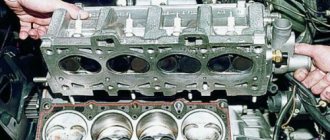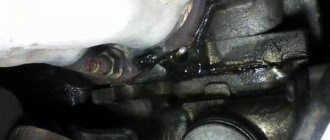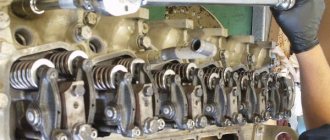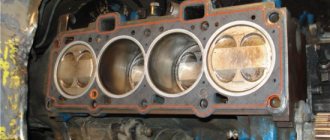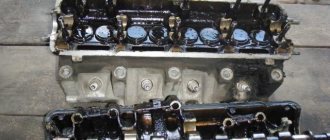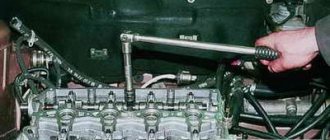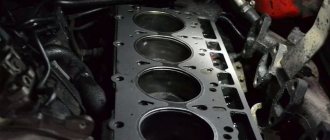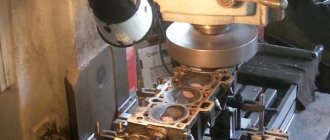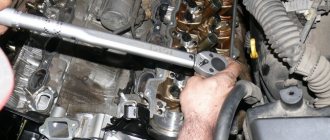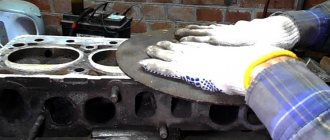When the level of coolant in a car engine suddenly begins to drop, the last thing they think about is the walls of the cylinder block, and especially the cylinder head. But when more and more obvious sources of leakage are excluded, and it comes to pressure testing the system, it is discovered that antifreeze is leaking through leaky plugs in the walls of the cooling jackets of these most massive engine parts.
Replacement procedure
First of all, you need to make the area in which the stub is located accessible. To do this, follow these steps (in this order):
- Disconnecting the exhaust pipes of the muffler from the exhaust manifold.
- Removing the bracket on which the pump pipe for supplying coolant is fixed.
- Disconnecting the hoses that provide ventilation to the unit from the carburetor and cylinder head cover. Closing the carburetor with a special cover.
- Removing the air filter.
- Disconnecting the wires from the carburetor, ignition distribution sensor, spark plugs.
- Removing the sensor that distributes the ignition.
- Disconnecting hoses from the fuel pump, outlet pipe, vacuum brake booster.
- Disconnecting the air and throttle valve drive cables.
- Removing the toothed belt protective cover.
- Removing the pulley with key.
- Removing the cylinder head.
Direct replacement of the plug includes the following:
- Rotating the plug into the cylinder head using a chisel and hammer.
- Pry the plug with pliers and remove it. If the part is very rusty and does not turn, you need to make a hole, screw a knob into it and pull out the plug.
- Cleaning the edges of the cylinder head hole from corrosion using sandpaper. Lubricating the edges of the new part with a sealing agent.
- Pressing the part into the cylinder head hole using a mandrel and a hammer.
How does CO work?
CO scheme
- On the 8-valve injection VAZ 2110, the cooling system operates due to coolant forcedly circulating through it. When the engine heats up, excess pressure arises, which is released through the exhaust valve.
- For the 16 valve injection VAZ 2110, the cooling system has an optimal operating temperature in the range of 90-95 degrees Celsius. And the valve is activated when pressure occurs with indicators from 1.2 to 1.4 kgf/cm2.
- When the excess pressure is released, the engine returns to normal temperature and the intake valve is turned on. This happens cycle after cycle.
- If the pressure balance is disturbed, overheating occurs, the consequences of which can be various types of breakdowns, including the need to completely replace the power unit.
- Due to the operation of the thermostat and electric fan, the VAZ 2110 maintains the required constant operating temperature. There is a sensor on the cylinder head that transmits information about the current coolant temperature to the control unit.
- A command is sent from the coolant temperature sensor to the cooling system, which begins to work in order to reduce engine heating.
- If there is electronic injection in the car design, it also has a special sensor that sends a message to the electronic control unit about overheating of the power unit.
- The pump supplies coolant, distributed by the thermostat.
- When you turn on the engine, it needs to warm up to operating temperature. To do this, the thermostat directs the coolant through a small circuit, without including circulation through the radiator. The small circuit includes: Heater for warming up the interior;
- Carburetor heating unit (naturally, only on carburetor VAZ 2110);
- Heating of the throttle unit;
- Intake manifold.
How to replace engine plugs
Replacing the VAZ cylinder head gasket
Plugs are plugs that are expanded by the impact of the striker after installation in the hole. Perhaps this information will be useful to you when purchasing.
How to find stubs
Two cup-shaped plugs are located in the engine block, under the manifold mounting points.
The plugs are located in various places in the cylinder block and cylinder head.
They cover the holes formed during the casting of these parts.
The plug is a weak point that, if overheated or frozen, can be damaged by the pressure of expanded coolant. If there were no plugs, the engine housing would crack at such moments.
Types of Stubs
The dome-shaped plugs are inserted all the way into the collar. Cup-shaped plugs are recessed inside so that the rim extends slightly beyond the recess.
In most cases, the plugs are located: on the side surface of the block, under the manifold; inside the clutch housing or above it, in close proximity to the transverse partition; at the top of the cylinder head, under the overhead camshaft.
Sometimes the plugs fly out completely, causing a sudden loss of coolant. In addition, liquid may leak little by little through the rusted edges. Small leaks leave marks on the block. Examine the block to find them.
Some plugs are hidden from the naked eye. Use a mirror to look into hard-to-reach places, such as behind a block. Remember that plugs come in different sizes, so measure the holes you need before purchasing.
It is possible that to gain access to the plugs you will have to remove the carburetor.
In some cases, in order to change the plugs on the bulkhead side, it is necessary to remove the entire engine. It is better to entrust this procedure to specialists.
Do not try to make a hole in the partition. This is a load-bearing structure, and if the hole is not repaired, the vehicle's warranty may be void. A simple rivet is unlikely to satisfy the insurance company.
Disconnect the battery and drain the cylinder block. If you plan to reuse the fluid, collect it in a clean container (see How to Flush an Engine Radiator).
Before pouring, strain the liquid through a thin cloth. Check the concentration of the solution (see section Checking and adding antifreeze).
There are two types of plugs - cup-shaped and dome-shaped. The installation methods for such plugs are different.
How to remove the plug
The cup-shaped plug can be pulled out with two pairs of pliers.
Plugs of any type are removed using a thin screwdriver. Use a blade to pierce the center of the plug and pull it out.
Remember that the movement must be uniform. Otherwise, the plug will become skewed and get stuck.
Use a screwdriver to pierce the old plug and pull it out.
In some cases, the edges of the cup-shaped plug stick out quite a bit and can be grabbed with two pairs of pliers. When pulling out the plug, apply equal force on both sides. Do not try to use the screwdriver as a lever and rest it on the block, so as not to damage the groove itself.
Remove any remaining old caulk with a wooden tool.
How to replace the plug
Use the correct size holder to install the cup plug.
Lubricate the plug and hole with sealant.
Insert the dome plug with the dome facing out. Make sure it is not skewed. Tap the center of the plug with a striker to expand it. The plug must fit firmly into the hole.
Use the striker to install the domed plug.
To install the cup plug, find a holder that fits snugly into the cup. Place the plug at right angles to the hole and then hit the holder with a soft hammer.
Make sure that the plug does not bend and remember that its edges should protrude slightly beyond the hole. This will make it easier for you to remove the plug if necessary.
On some older BL series engines, the plugs in the engine base plate are installed using a bolt.
In some designs there is simply no place to swing a hammer to install the plug. For example, on Leyland B engines the dome plugs, hidden by the base plate, are directly opposite the baffle, but there are special holes in the base plate.
Insert a new plug, insert a 50 mm long bolt into the hole, put a nut on it and tighten it a little to press the plug into the groove.
This method is also used for other problem areas.
Application areas of plastic plugs
Plastic pipe plugs can be used:
- in plumbing during the construction and use of pipelines. The most common fittings are used:
Plug on the pipeline compartment intended for system inspection
as a temporary limiter. For example, a partially constructed pipeline must be urgently put into operation. Using a plug, you can cut off one branch of the highway from another;
Plug that temporarily restricts the passage of water
a fitting installed at the end of a pipe. For example, when installing storm drains around the house;
Plug for a rain gutter installed around the perimeter of the roof
if a pipeline breaks, so as not to completely stop the supply of water or sewerage;
- Plastic plugs for profile pipes are used in furniture production. For example, to protect the floor covering from wear due to the legs of tables and chairs;
Plastic devices used in the manufacture of furniture
- in the manufacture of fences or other products where posts or profiles are used. Plastic plugs for pipes and profiles can serve to protect the structure from clogging and simply as decorative elements;
Fitting to protect the fence frame from clogging
- as protective elements when transporting pipes.
Fittings used to protect pipes during transportation
The wide range of applications and various shapes of pipes is due to the production of a large assortment of plastic plugs.
Replacing the resonator
Boring and lining of the cylinder block
Resonator VAZ 2110
- The resonator is attached to the muffler using a crimp clamp with an O-ring;
- It is attached to the neutralizer by means of a floating flange (two bolts) and flaring;
- On the opposite side of the neutralizer there is a “fist”;
- It is often problematic to unscrew the knuckle mounting bolts; they are simply cut off with a grinder and replaced with new ones;
- If suddenly you don’t have a tool at hand, we clean the places where the bolts are attached and treat them with a “liquid wrench” (WD-40 or its equivalent);
- Unscrew the bolts and remove the muffler clamp;
- We remove the resonator from the suspension rubber bands, change the rubber bands if necessary;
- Then we hook a new resonator onto rubber bands and attach it to the muffler so that the pipe running from the resonator to the muffler is parallel to the ground;
- When there is wear on the neutralizer fist or there are burrs, grooves or rust on it, it is necessary to lubricate the connection with a special high-temperature sealant;
- Using new bolts and nuts, tighten the flanges of the catalyst and resonator;
- The neutralizer is attached to the resonator by means of a flange connection (two bolts), to the receiving pipe (pants) by means of a spring-loaded connection and a pair of flares, between which there is a graphite or metal-asbestos ring.
Composition of the output unit
The exhaust system for a VAZ 2110 car consists of the following elements:
- Exhaust manifold;
- Lambda probe;
- Receiving type pipes;
- Neutralizer;
- Two mufflers: main type and additional.
Not all exhaust components are disassembled; some parts, such as the converter, as well as both mufflers, are replaced entirely.
Description of individual components
To make the structure of such an element as the discharge system clearer, it is necessary to give a detailed description of all components:
- Neutralizer. A unit designed for effective purification and suppression of emissions of harmful substances into the environment. When driving, a car produces substances such as non-combustible hydrocarbons, oxide compounds of nitrogen and carbon. The work of this system is aimed at eliminating them. The design itself is a combination of two ceramic-type components. The surface of these components is coated with special afterburning catalysts, which include rhodium, palladium and platinum. These substances make it possible to purify exhaust gases emitted into the environment by almost 100%;
- Lambda probe. It is a special sensor whose task is to control the composition and amount of fuel that enters the engine. The lambda probe thereby controls the purifier. If the lambda probe does not work properly, then the entire output assembly will quickly become unusable, after which it will have to be replaced;
- Reception pipe. Designed for forced removal of exhaust gases from the cylinders of a power unit. The pipe is made of stainless steel, and its fastening to the collector is carried out using special pins, of which there are four in total. The studs guarantee reliable fastening of the two outlet pipes and the element. In order to combine the exhaust pipe and the neutralizer, as well as an additional muffler, hinged fasteners are used;
- An exhaust manifold. A component that is cast from pure cast iron. The manifold is secured with four studs in the exhaust pipe. Heat-resistant gaskets reinforced with metal are installed between the manifold and cylinder heads.
- Silencers. Necessary for effectively suppressing the exhaust rate of burnt gases. This is necessary in order to significantly reduce the noise level in a type of transport such as the VAZ 2110. The distribution device in this part of the unit is carried out as follows: the additional one is followed by the main one. These two components are connected to each other by clamps and sealing rings and are covered with a special casing on top.
Nuances of operation
There are some points that need to be taken into account when operating the VAZ 2110 system:
- Under no circumstances should the vehicle be refueled with leaded fuel, as this will cause damage. It is very sensitive to lead compounds;
- When operating a VAZ 2110 car, you also need to monitor the proper, precise operation of the ignition, since its poor-quality operation leads to the neutralizing part being removed from its working condition. Fuel that does not burn when a spark passes during ignition enters the converter and burns out there. For this reason, the ceramic coating of the component quickly deteriorates;
- Frequent malfunctions will sooner or later lead to complete or partial blockage of the output system, in turn to the failure of the engine and its repair or replacement will be required.
Troubleshooting
The operation of a machine is always associated with the occurrence of malfunctions in parts and mechanisms. If some parts become unusable, then they need to be replaced or repaired yourself.
To replace the additional muffler in the exhaust unit:
- unscrew the two bolts that secure the clamp, for this you need a 13mm wrench;
- remove the clamp itself;
- remove the ring;
- disconnect the additional suspension cushions;
- remove the unit.
After this, a replacement is made, it is mounted in place in the reverse order. These are basic troubleshooting repair steps.
In addition to replacing standard faulty components with the same ones, but only new ones, you can modify individual components of the exhaust system, or tune the entire assembly.
If you find an error, please select a piece of text and press Ctrl+Enter.
7.2. Removing and installing cylinder block plugs
| Tighten the cylinder head bolts correctly, basic rules and requirements for performing the work | Rice. 67. Front part of the cylinder block: 1 — spring tension pin; 2 — chain guide support pin; 3 — steel ball with a diameter of 17 mm; 4 - oil spray nozzle; 5 — cylinder block plug; 6 — support pin of the chain tensioner shoe; 7 — support pin of the oil pump drive chain tensioner |
| Rice. 66. Rear part of the cylinder block indicating the location of the steel ball (1) blocking the main oil line and the plug (2) of the cylinder block |
There are hole plugs installed on the sides and ends of the cylinder block, which are squeezed out of the block if the coolant freezes. On the side of the coolant drain plug on the cylinder block there are two plugs with a diameter of 34 mm, and on the opposite side (on the oil filter side) there are two more plugs of the same diameter. On the end side of the crankcase there is one plug 5 (see Fig. 67) with a diameter of 17 mm. Another plug 2 (see Fig. 66) with a diameter of 34 mm is pressed into the front end side of the cylinder block. These plugs can be changed if the coolant freezes without removing the engine, but using a special tool. To do this, you must perform the following operations:
– drain the coolant;
– remove parts and assemblies that may interfere with access to the plugs;
| Rice. 69. Installing a screwdriver or chisel to remove cylinder block plugs |
| Rice. 70. Removing the plug from the block |
– place a narrow chisel or a powerful screwdriver under the edge of the plug (Fig. 69) and use a hammer to turn the plug in the hole 90° around its axis (Fig. 70);
– grab the plug with pipe pliers and pull it out of the cylinder block, as shown in Fig. 70;
– thoroughly clean the mounting hole of the plug in the cylinder block. There should be no traces of grease left on the sealing surface;
– coat the mounting hole with Loctite fixing agent and insert a new plug using a special mandrel (specification number 00) or another suitable mandrel so that it is flush with the surface of the cylinder block;
– install all the removed parts in their places and after a pause of 45 minutes, pour coolant into the engine if it was not removed from the car;
– then start the engine and check it for leaks.
| previous page2.7.1. general description | next page 2.7.3. Measuring the working clearance in the pistons |
Principle of operation
In short, the cylinder head is responsible for forming the combustion chamber, supplying the combustible mixture to the chamber and further removing exhaust gases. In words everything is quite simple, but let's look at everything in detail. So, when the engine starts, the cylinder head comes into operation. Here's what happens:
- The camshaft pushes a rod, which then puts pressure on the hydraulic compensator and rocker arm;
- The rocker puts pressure on the valve, which immediately opens. Valves in diesel internal combustion engines are somewhat different from their gasoline “counterparts” in functionality;
- The valve ends up in the combustion chamber, where the mixture is ignited by the spark plug;
- Exhaust gases are discharged into the exhaust manifold;
- The spring returns the valve to its original position. The cycle repeats.
In diesel engines, the mixture is ignited by compression, so the key parameter is the synchronization of fuel injection by a special diesel injector with the opening of the intake valve. In the case of the cylinder head of both gasoline and diesel engines, the tightness of the gas joint
- if it loses its seal, the fuel will not burn completely and the engine will be more difficult to start. Also, with loss of tightness, one can note increased noise of the engine and its accelerated wear during operation.
Replacing the cylinder block plug of a VAZ 2110
VAZ – Blank plug for VAZ block. Lada Niva Replacement of aluminum head plug for VAZ 21011. Lada Samara Repair of cylinder head for VAZ 2110. etc. Washing injectors (cleaning the injector).
Replacing the VAZ 2110 engine mount. 0 0 443. Do it yourself At home - how to make an arc reactor. Replacing front springs on a VAZ. 0 0 125. Replacement of corrugation for Opel. Saint Petersburg.
https://youtube.com/watch?v=BWUmh342ixY
Replacing cylinder block plugs. Do it yourself! Views: 31487. Remon | VAZ 2109-08 Replacing the cylinder block plug.
Lada 21099 Brunette › Logbook › Replacing the cup plug of the cylinder block. 23 years old I drive a Lada 2110 Zavolzhye, Russia.
Replacement of the plug in the VAZ-21083 cylinder block and modifications based on block 21083. Replacement of the VAZ 2110 heater radiator.
Repair of the VAZ 2110 stove (heater). We eliminate creaks and rattles in the door trims of the VAZ 2110. Eliminate oil leaks from under the cylinder head plug from the my2110.ru forum. Interesting photo reports: Replacing the gearbox ball joint race.
Replacing the oil seals of the 16 valve VAZ 2110 2111 2112 engine. On the VAZ-2111 engine, using a “10” wrench, unscrew the two nuts securing the “mass” wires to the studs of the cylinder head plug
Avto-mechs.ru » Video gallery » Video do-it-yourself auto repair: Leaking cylinder block plugs for VAZ-2109 plugs for Free videos on how to put a timing belt on a scooter. replacement of hub bearing for VAZ 2109. Opel Astra N 1.3 diesel spare parts.
Cylinder head parts: 1 – cylinder head; 2 – intake 1. Remove the cylinder head from the engine (see “Replacing the cylinder head gasket”). Repair, operation and installation of VAZ 2110, 2111, 2112 cars.
replacing engine plugs. VAZ cylinder block 2108-09-10. viburnum. . What will happen if you wash the engine of a VAZ 2110? Many people are afraid to wash the engine of their car, but I do it regularly, so far everything is fine!
Cooling channel plugs in the block? Topic author Arifmon, 3.5.2011, 22:22. What paint should I paint the cylinder block??? Is it some kind of special heat-resistant paint or regular paint over a regular primer???
On the other side of the cylinder head we press in the plugs. We remove the timing belt (see Replacing the timing belt on VAZ-2110, -2111 engines).
How to replace the cylinder head gasket on a VAZ 2110. 5. Disconnect the exhaust pipe of the muffler from the exhaust manifold (Replacing the exhaust pipe of the muffler>>>).
► replacing engine plugs. VAZ 2108-09-10 cylinder block. Kalina. Alexander Skripchenko. It is shown how you can replace plugs (plugs) on a VAZ engine block with your own hands.
They did it, which they regretted later. We had to take it apart again. And the plug that plugs the block where the antifreeze is located rusted. We knocked it out with a chisel and a hammer, then pulled it out with Hyundai pliers. Kia. Lada (VAZ).
You dig it out in any way, you won’t damage the block, then you take the plug (it came from a VAZ-2109) and use a copper adapter without sealant or any nonsense to hammer it in so that it fits in smoothly and that’s it. December 14, 2013
A nice bonus is the presence of a mark on the flywheel, which can be seen under the rubber plug on top of the gearbox, here is a photo. Replacing the VAZ-2110 heater motor. Replacing the wheel bearing.
Install the cylinder head with the bearing housings facing up, placing wooden shims underneath to prevent damage to the valves. Repair and operation of VAZ 2110, 21102.
Making plugs
It happens that it is not possible to buy a new plug or the cost of the part is more than the cost of making it yourself. In factories, this part is usually made by extruding it from a sheet of metal and cutting off the outline.
Replace the plug when necessary to avoid engine problems. Carefully read the algorithm presented above to understand how the procedure for changing a part is carried out.
- Are you here:
- home
- Anthers, covers, plugs.
- Camshaft plug VAZ 2112
Plug for the camshafts of the cylinder head of the VAZ 2112. Article: 2112-1003290 The first of the possible reasons for the “knocking out” of the plug is an insufficiently tight connection with the cylinder head. With this defect, there is a threat of ignition of the ejected oil, hydraulic compensators of timing valves may knock (cooling of friction pairs and their lubrication worsen), and non-oil-resistant hoses of the cooling system may deteriorate.
What to do after replacement
So, the plug has been replaced and is no longer leaking, all that remains is to return the cylinder head to its place. To do this, follow these steps:
- Cleaning the cylinder head from contaminants and formations using diesel or kerosene.
- Removing remaining coolant from threaded holes.
- Cleaning the cylinder head mating surfaces from the old gasket, degreasing them with a solvent.
- Installation of the head on the BC.
- Head fixation. The fastening bolts are immersed with threads in motor oil. When the lubricant drains (about half an hour), the head is fixed.
- Putting the belt on the crankshaft pulley.
- Tension the belt counterclockwise.
- Installation of the belt drive protective cover (the mounting bolts are not tightened). Turn the crankshaft 2 turns (the belt should be tight even when the crankshaft is stopped). Checking the alignment of the mounting marks on the camshaft pulley and the cylinder head cover. Tightening the bolts securing the tension pulley bracket.
- Installation of drive cables for carburetor flaps.
- Connecting the removed hoses.
- Installation of the ignition distribution sensor.
Now you need to set the ignition timing. To do this, do the following:
- Connecting wires to the carburetor, ignition distribution sensor.
- Installing an air filter.
- Filling the cooling complex with antifreeze/water.
- Connecting the negative cable to the battery.
- Checking the functioning of the internal combustion engine.
Antifreeze or antifreeze flows through the plug; replacing the plug in the engine block with your own hands
Let's start with the fact that the problem of coolant leaking through plugs is most common on older domestic cars. However, this malfunction does not bypass various foreign cars. To restore tightness to the cooling system if it leaks through a plug in the block, the specified plug must be replaced. Let's look at such a replacement using the example of a VAZ car.
So, the plug (cup plug of the engine block) is installed in six places. The five larger plugs are 40mm in diameter, and the slightly smaller one is 25mm in diameter. The plugs must be changed in a certain sequence.
Before replacing, in addition to the new plugs themselves, you need to prepare:
- hammer;
- chisel;
- screwdriver;
- pliers;
- sandpaper;
- sealant;
Experts, regardless of engine type and time of year, recommend using only high-quality antifreeze or antifreeze diluted with distilled water in the required proportions, but not running or even distilled water.
You also need to remember that any antifreeze has a limited service life (maximum 4 years), and mixing different types of coolant with each other is also prohibited. Also used to flush the engine cooling system.
Antifreeze or antifreeze in the cylinder block: what to do and how to solve the problem. ... As a result, the permeability of the channels deteriorates, oil circulation is disrupted, and filters quickly become unusable.
As a rule, the color of antifreeze or antifreeze in this case changes to... If you remove the oil filter, then you can also notice sticky deposits inside it. ... How to eliminate an antifreeze leak: causes and possible...
The plugs in the cylinder block are integral elements of the unit. If liquid begins to leak from the cooling system, the root cause may be plugs that have become unusable. The appearance of holes is caused by rust that forms during the operation of the car. Replacing plugs on a VAZ engine can often eliminate such problems, and installing new ones yourself does not take as much time as compared to engine repair.
Why do they make plugs in the cylinder head?
In the head, and also in the block, plugs are installed at the factory to block the technological holes in the walls of the castings. It is very difficult to produce such large parts with high precision using casting. It is necessary to ensure that there are no internal cavities or cavities in the castings. For this purpose, additional channels are used, through which excess pressure is released and gases are removed.
After casting is completed, the workpieces are machined, all holes and channels are brought to nominal sizes, shape and surface cleanliness. The technological openings are closed with metal plugs, which ensures the tightness of the cooling jackets.
Over time, metals are subject to corrosive wear. If you use high-quality antifreeze and change it on time, then you won’t have to worry about this problem for decades. The parts are thick-walled, and the corrosion rate is minimal, since antifreeze contains a supply of effective additives that inhibit these unwanted chemical reactions. They work both on iron in the composition of steels and cast irons, and on aluminum in the composition of light alloys.
On the subject: How often to wash your car and with what
But cars are not always maintained as prescribed in the instructions. Antifreeze is not changed for a long time, and some people, out of habit and to save money, fill it with water.
Corrosion begins immediately and quickly eats through the metal of the plugs. Or it creates a leak at the junction of the plug with the main part. The fluid runs out, the engine overheats, you can’t drive like this anymore.
Repair of exhaust system parts
- It is possible to weld parts of the exhaust system only if they have been damaged as a result of mechanical impact
- In the event that a pipe breaks, or a weld seam or tank burns out, you need to replace the entire element, it has already become unusable
- The only part to which this does not apply are metal expansion joints. They change regardless of the exhaust system itself
- The cost of the neutralizer in comparison with other elements of the system is decent. Therefore, many people change it to a stronger (flame arrester)
- The neutralizer is cut off, leaving only the connecting flanges, as well as a fist with flaring, and a flame arrester is welded in
- The cost of a flame arrester is much lower than a neutralizer. However, there is no afterburning of fuel residues. Therefore, its installation is permissible on cars with one lambda sensor. In addition, the flame arrester increases fuel consumption by about 10-15%.
Replacing plugs for VAZ 2110
Car owners often encounter the problem of fluid leaking from the cooling system. Often the reason lies in rusted or squeezed out plugs in the engine cylinder block. To fix the problem, just replace them with new ones.
Plug locations
- There are plugs on the sides and ends of the cylinder block that are squeezed out of the block when the coolant freezes in it.
- Two plugs with a diameter of 34 mm are located on the cylinder block on the side of the coolant drain plug, and two more on the oil filter side
- There is another plug with a diameter of 17 millimeters on the rear end side of the crankcase
- The last plug with a diameter of 34 mm is located at the front end of the cylinder block
These plugs are changed if the coolant in the cylinder block is frozen. The plugs can be changed without removing the engine. On a VAZ 2110, replacing the cylinder block plugs is done using a special tool. To do this you will need:
- beard or chisel
- hammer
- pliers
- durable screwdriver
- telescopic magnetic pointer (purchased at any automotive store)
- new plug
- sealant
- skin
Let's sum it up
It is well known that overheating is one of the most common reasons why an internal combustion engine can be seriously damaged or fail completely. At the same time, repair and restoration of an overheated internal combustion engine turn out to be very costly operations in practice; sometimes it is necessary to replace the engine with a contract engine, etc.
At the same time, the efficiency of the cooling system directly depends on the quality and condition of the coolant, its level, as well as the cleanliness of the channels of this system themselves. In order to avoid problems with corrosion, get rid of the formation of scale and deposits, and also eliminate the risk that the liquid in the cooling system will freeze in winter, you need to use special coolants. Otherwise, the thermostat may quickly begin to work incorrectly, the pump impeller will be damaged, etc.
You also need to remember that any antifreeze has a limited service life (maximum 4 years), and mixing different types of coolant with each other is also prohibited. Even before replacing antifreeze or antifreeze, the engine cooling system must be flushed using special or household products for flushing the engine cooling system.
Why does engine oil get into antifreeze: the main causes of this malfunction. What will happen to the engine if oil is found in antifreeze or antifreeze?
Reasons why coolant starts to leak. How to find the location of an antifreeze or antifreeze leak yourself. Useful tips and tricks.
Why do antifreeze or antifreeze enter the engine cylinders and what to do in such a situation. How to determine the presence of antifreeze in the cylinders yourself, repair methods.
Replacing the coolant working fluid of the engine cooling system. Features of the draining procedure. Removing antifreeze residues from the cylinder block.
How to unscrew a broken pin or broken bolt from an engine block and other components. Methods for unscrewing a broken bolt, useful tips.
Causes of oil leaks in the oil filter area: oil flows from under the filter, through the housing, in the area of the fitting, etc. Available diagnostic and repair methods.
How to replace the cooling system plugs on a VAZ 2110? Easily! _ VK group: vk.com/vilisovivan
